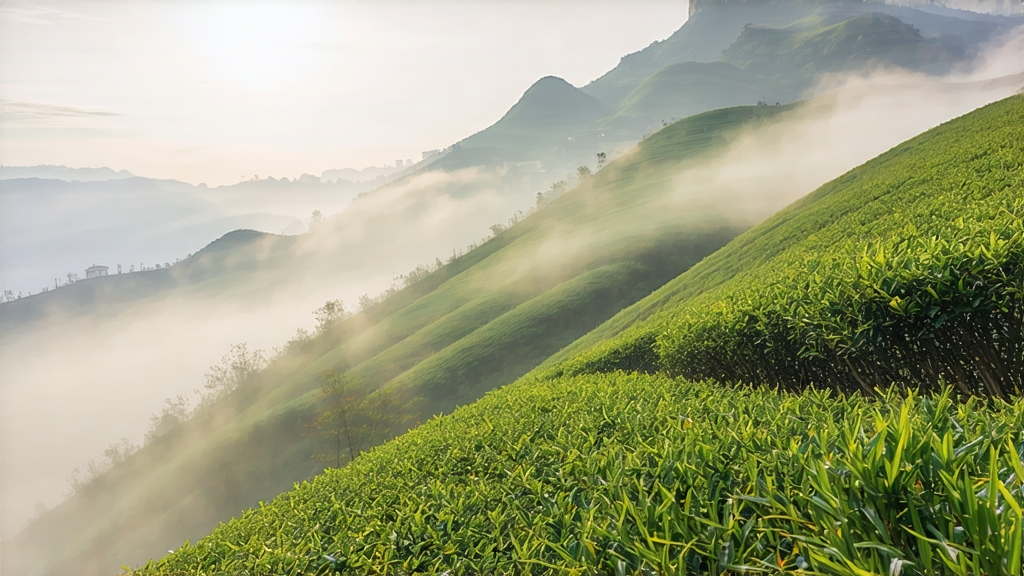
High on the shoulders of Mt. Mengding, where Sichuan’s clouds brush the bamboo tops and the Min River glints far below, a tea once reserved for emperors still unfurls its golden buds each early April. Meng Ding Huang Ya—literally “Mengding Yellow Bud”—is the least-known member of China’s six great tea families, yet in the Tang dynasty it was the first tea ever taxed, and in the Song it rode on silk-clad sedan chairs to the palace gates. For a thousand years its yearly harvest was measured not in tonnes but in tribute ounces; then, almost overnight, it vanished from the world market, hidden behind the louder fame of green Longjing and pu-erh cakes. Today a small circle of Sichuan farmers, some the seventh generation of Song-dynasty pickers, are quietly coaxing the yellow bud back to life, preserving a craft so subtle that one mistimed breath can turn imperial gold into common green.
History: from imperial tax to near extinction
The first written record appears in 753 CE, when the monk Wu Lizhen planted seven tea bushes on the summit of Mengding, an act still commemorated by a stone stele. By 805 the Tang court had decreed that only tea from these bushes could be presented at the spring altar; any commoner caught picking faced exile. Song emperors expanded the privilege to the entire northeastern slope, and Yuan cavalry carried the dried buds in yak-skin pouches to the Mongol capital. The Ming rebuilt the mountain shrines, but the Qing, distracted by opium and rebellion, let the tribute system collapse. When railways reached Ya’an in 1908, green tea could be rushed to Chengdu in a day; the slower, more delicate yellowing process was abandoned by all but a few monasteries. During the Cultural Revolution the old cultivars were slashed to plant sweet potatoes. Not until 1982 did the Sichuan Tea Institute, guided by a single surviving 1893 ledger, re-graft original scions and recreate the lost micro-climate of mist, altitude, and soil bacteria that allow the buds to “smile” yellow.
Micro-terroir: why the mountain itself is an ingredient
Mengding sits at 29.9° N, the same latitude as the gardens of Darjeeling, but its eastern face catches the monsoon and its western cliffs exhale cool air all night. The result is a 90 % average humidity and a temperature curve that dips 8 °C between noon and dusk—ideal for the slow enzymatic oxidation that defines yellow tea. The soil is a crumbly quartz-rich loam, so porous that a 30 mm shower drains within an hour, forcing roots to dive three metres for minerals. Indigenous bamboo and wild camellia populate the understory, their leaf litter inoculating the ground with actinomycetes that later join the fermentation dance inside woven bamboo trays. In short, the mountain is not merely the backdrop; it is the invisible master blender.
Cultivar and picking code
Only two clones are recognised as true Meng Ding Huang Ya: the small-leaf “chuancha 9” and the broad-leaf “huangyazao”. Picking begins when the dawn mist still hides the sun, at the “one bud, just unfolding” stage—roughly 15 mm length, still clad in down like a newborn deer. A team of 120 pickers can finish the 300 mu certified garden in four mornings, plucking exactly 1.2 kg of fresh buds each, enough for 200 g of finished tea. Leaves touched by rain are rejected, as surface moisture dilutes the withering aroma; instead, pickers wait for what locals call “ghost moisture”, the invisible film that condenses when mountain breath meets valley breath.
Craft: the secret of sealed yellowing
Yellow tea is often described as “green tea with an extra step”, but that step is a labyrinth of timing and anaerobic chemistry. The sequence is: kill-green → wrapping → piling → second wrapping → low-temperature drying, each transition decided not by clock but by scent.
- Kill-green: buds are tossed in a 160 °C wok for 90 seconds, just long enough to rupture 60 % of leaf cells while keeping the central vein alive. The master listens for the “popcorn note”, a high-pitched crack that signals the release of bound amino acids.
- First wrapping: the hot